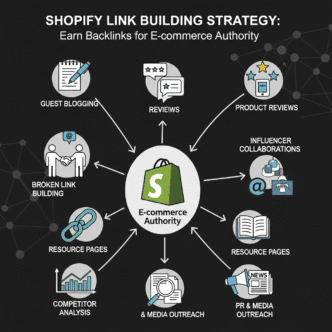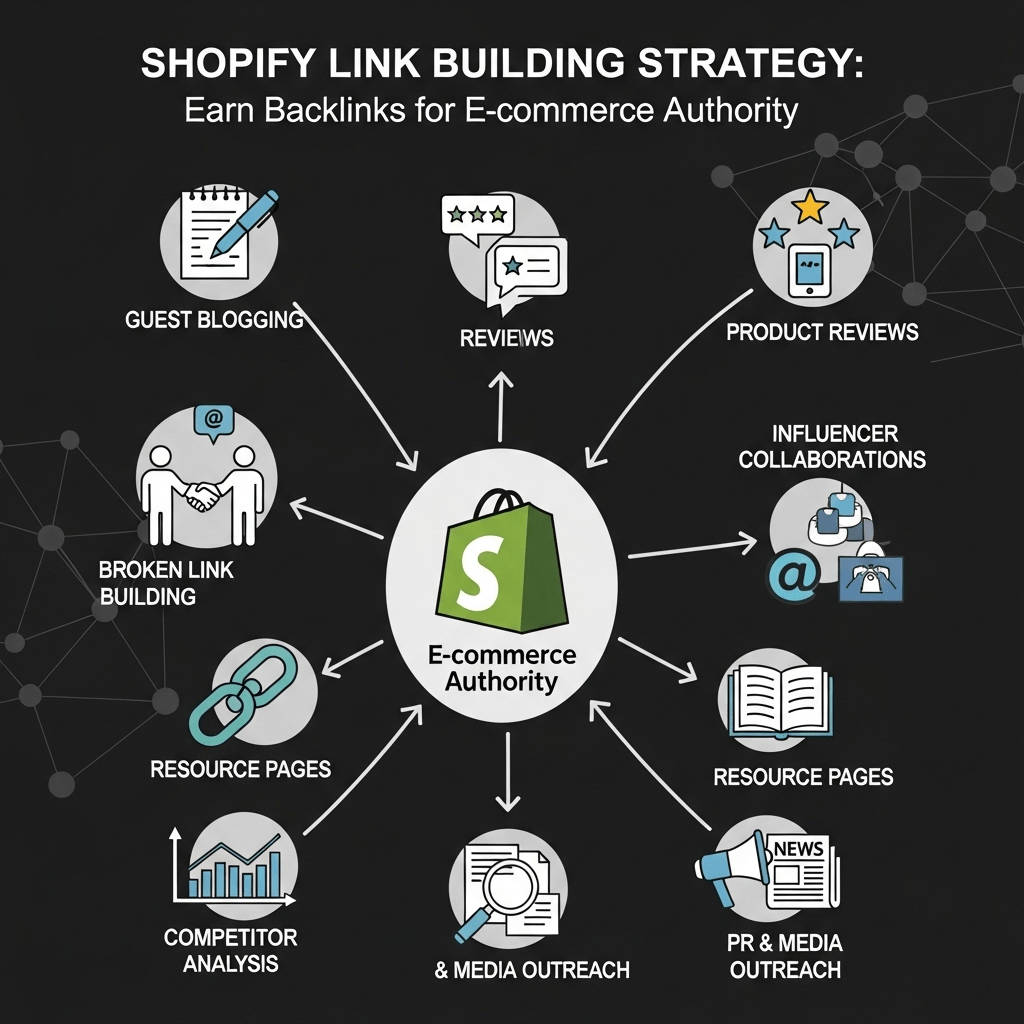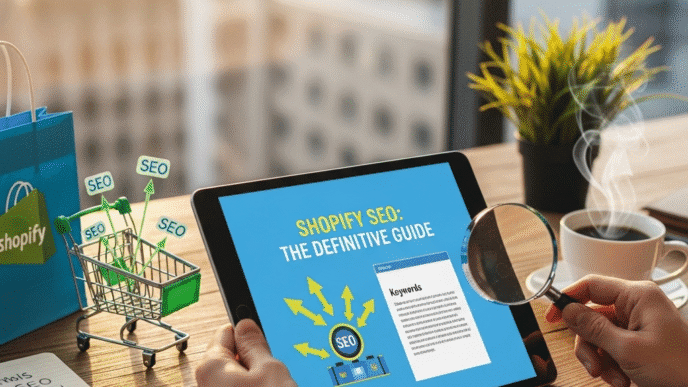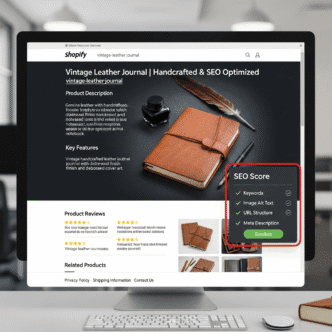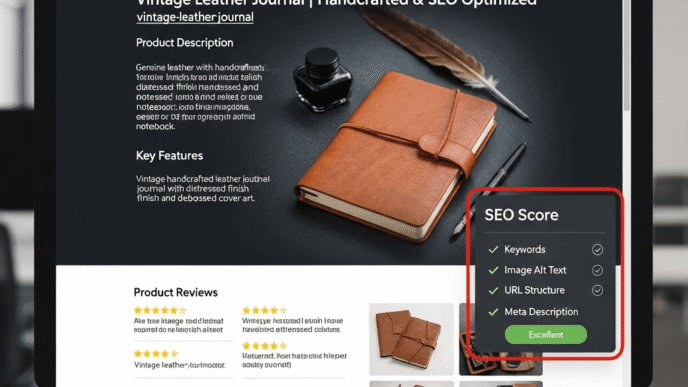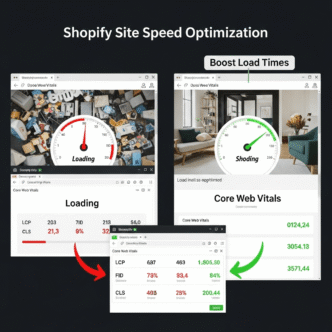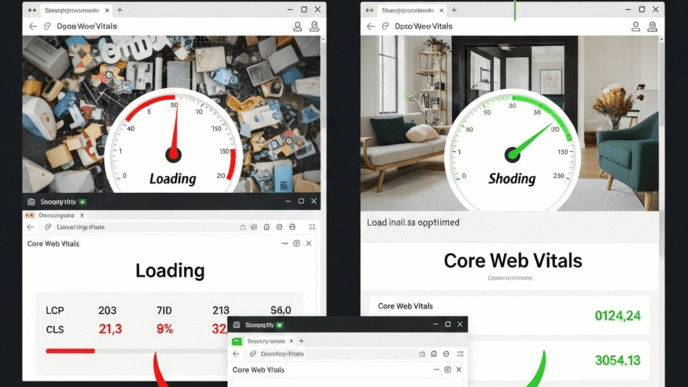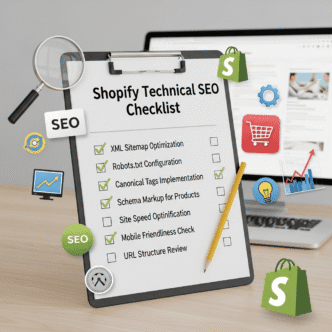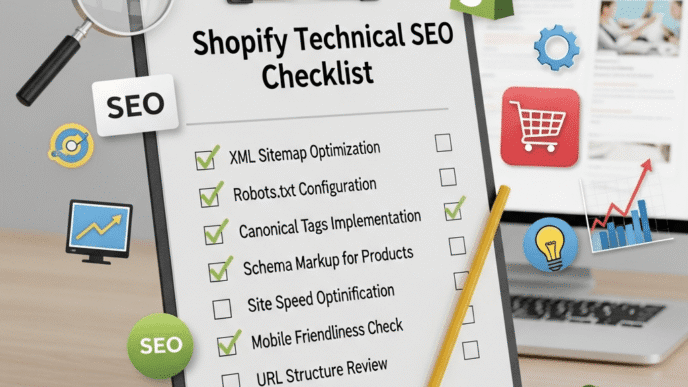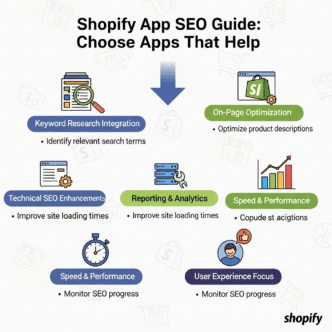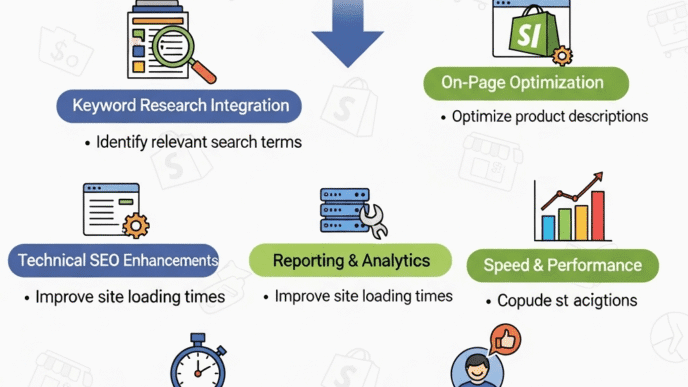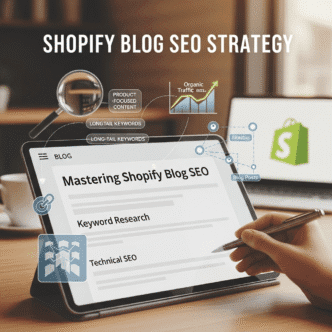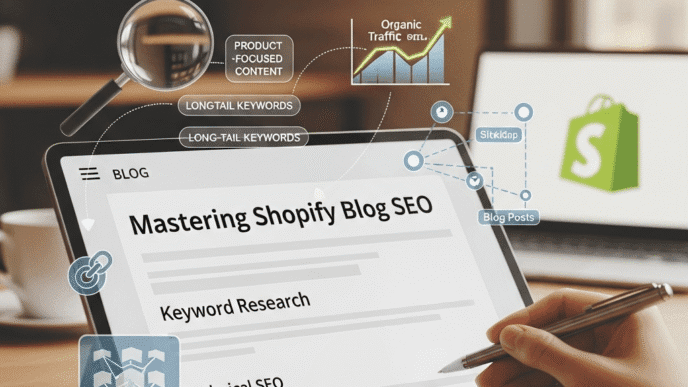Your Shopify store has perfect on-page SEO. Your content is solid. Your technical setup is flawless. But you’re still stuck on page 3, watching competitors with worse products outrank you.
What gives?
Here’s the brutal truth: they have links. You don’t. And in Google’s eyes, that makes them more trustworthy, authoritative, and worthy of rankings than your store—regardless of how perfect everything else is.
Shopify link building is the secret sauce most e-commerce stores completely ignore. They obsess over product descriptions and meta tags while their competitors are quietly building relationships, earning mentions from industry publications, and stacking backlinks that push them to page one.
The painful irony? Product pages are notoriously hard to earn links to. Nobody naturally links to your “Blue Running Shoes” product page. Blogs, resources, and content are what earn links—which means e-commerce SEO requires a completely different link building approach than traditional websites.
Most Shopify stores either give up on backlink strategies entirely or waste thousands on spammy link packages that do more harm than good. Meanwhile, smart stores are using strategic content, PR tactics, and relationship building to earn high-authority links that actually move the needle.
In this comprehensive guide, I’ll show you proven link building strategies for Shopify stores to increase domain authority—from content-driven tactics to relationship building to leveraging your products themselves. No black hat BS. No spam. Just white hat strategies that work in 2025.
Let’s turn your link-starved store into an authority that dominates search results.
Table of Contents
ToggleWhy Is Link Building Still Critical for Shopify SEO?
Let me settle this debate: despite Google’s evolving algorithm, backlinks remain one of the top 3 ranking factors. Period.
Backlinks = Trust Signals: When authoritative sites link to yours, they’re essentially vouching for you. Google interprets this as: “If these trusted sites reference this store, it must be legitimate and valuable.”
Domain Authority Impact: Higher-quality backlinks increase your Domain Authority (DA) or Domain Rating (DR), making it easier to rank for competitive keywords.
Referral Traffic: Quality links don’t just boost SEO—they drive actual visitors who convert.
Competitive Necessity: In competitive e-commerce niches, the stores ranking on page one typically have 5-10x more backlinks than those on page three.
According to Backlinko’s analysis of 11.8 million Google search results, the #1 result has an average of 3.8x more backlinks than positions #2-#10. You can’t ignore this.
For foundational Shopify SEO before diving into link building, start with our definitive Shopify SEO guide.
What Makes E-commerce Link Building Different?
Product pages don’t earn links naturally. That’s the fundamental challenge of Shopify link building.
The E-commerce Link Building Challenge
Nobody Links to Product Pages: Bloggers don’t naturally link to “Men’s Leather Wallet – $49.99.” They link to helpful guides, data, and resources.
Limited Content Opportunities: Unlike blogs publishing daily, e-commerce stores have finite pages—products, collections, and maybe a blog.
Transactional Nature: Your site exists to sell. Most link-worthy content exists to inform. This creates tension.
Competitive Disadvantage: Media sites and blogs have teams creating link-worthy content. You’re one person trying to sell products and build links.
Why Traditional Link Building Doesn’t Work for Shopify
Guest Posting: Most sites won’t accept guest posts with commercial links back to product pages.
Directory Submissions: Low-quality directories provide minimal SEO value in 2025.
Link Exchanges: Reciprocal linking is obvious to Google and provides limited benefit.
Buying Links: Violates Google’s guidelines and risks penalties.
Broken Link Building: Harder for e-commerce since you’re pitching product pages, not resources.
You need e-commerce-specific strategies that work with your business model, not against it.
How Do You Audit Your Current Backlink Profile?
Before building new links, understand where you stand.
Essential Link Analysis Tools
| Tool | Best For | Cost | Key Metrics |
|---|---|---|---|
| Ahrefs | Comprehensive backlink analysis | $99-999/mo | DR, referring domains, backlinks |
| SEMrush | Competitive analysis | $119-449/mo | Authority Score, referring domains |
| Moz Link Explorer | Beginner-friendly | $99-599/mo | Domain Authority, spam score |
| Majestic | Historical link data | $49-399/mo | Trust Flow, Citation Flow |
| Google Search Console | Free, limited data | Free | Basic linking domain data |
| Ubersuggest | Budget option | $29-99/mo | Domain score, backlinks |
Step-by-Step Backlink Audit
Step 1: Choose Your Tool (Ahrefs recommended for serious stores)
Step 2: Enter Your Domain
Step 3: Review Key Metrics:
- Domain Rating/Authority: Your overall domain strength (0-100 scale)
- Referring Domains: How many unique websites link to you
- Total Backlinks: Total number of links (less important than referring domains)
- Dofollow vs Nofollow: Dofollow passes SEO value, nofollow doesn’t
Step 4: Analyze Link Quality:
- What’s the average DR/DA of sites linking to you?
- Are links from relevant, industry-related sites?
- Any spammy or low-quality links?
Step 5: Identify Top Linking Pages:
- Which of YOUR pages earn the most links?
- Usually homepage, blog posts, or resource pages
- Rarely product pages (this is normal)
Step 6: Check Competitors:
- Analyze top 3 competitors’ backlink profiles
- What’s their DR? Referring domains?
- Where are they getting links you’re not?
Step 7: Document Baseline:
- Current DR/DA
- Current referring domains
- Current total backlinks
- Top linking domains
- Link gaps vs. competitors
Pro Tip: According to Ahrefs’ study of 150,000 domains, there’s a strong correlation between number of referring domains and organic traffic. Focus on earning links from new domains, not just more links from existing ones.
What Content Should You Create for Link Building?
Since product pages don’t earn links, you need linkable assets.
High-Value Content Types for E-commerce Link Building
1. Comprehensive Buying Guides
Example: “The Ultimate Guide to Choosing Running Shoes” (if you sell running shoes)
Why It Works: Helpful, comprehensive guides earn links from blogs, forums, and resource pages.
How to Execute:
- 3,000+ words covering everything about the topic
- Include your products naturally as recommendations
- Add data, expert quotes, comparison tables
- Promote to relevant bloggers and publications
2. Industry Data and Original Research
Example: “2025 E-commerce Consumer Behavior Study: How 5,000 Shoppers Make Purchase Decisions”
Why It Works: Original data is highly linkable—everyone wants to cite unique statistics.
How to Execute:
- Survey your customers or industry participants
- Analyze sales data for trends
- Create visualizations (graphs, charts, infographics)
- Publish findings with embed codes for others to share
3. Expert Roundups
Example: “50 Fashion Industry Experts Predict 2025 Trends”
Why It Works: Featured experts share and link to the roundup.
How to Execute:
- Identify 20-50 industry experts
- Ask one simple question via email
- Compile responses into comprehensive post
- Notify all participants when published
- High likelihood of earning 10-20 links
4. Visual Assets (Infographics, Charts)
Example: “The Complete Guide to Shoe Sizes [Infographic]”
Why It Works: Visual content gets shared and embedded on other sites.
How to Execute:
- Create genuinely useful visual resources
- Provide embed code for easy sharing
- Reach out to relevant blogs offering the graphic
- Update annually to stay relevant
5. Tools and Calculators
Example: “ROI Calculator: How Much You’ll Save by Switching to [Your Product Category]”
Why It Works: Interactive tools provide unique value worth linking to.
How to Execute:
- Build simple calculators related to your niche
- Make them freely available
- Promote to industry blogs and publications
6. Controversial or Contrarian Content
Example: “Why You Shouldn’t Buy [Popular Product Category] (And What to Buy Instead)”
Why It Works: Controversy generates discussion and links.
How to Execute:
- Take a defensible contrarian stance
- Back it up with data and logic
- Promote in relevant communities
- Engage with responses and discussions
7. Industry Reports and Trend Analysis
Example: “State of Sustainable Fashion 2025: Market Analysis”
Why It Works: Comprehensive industry analysis earns citations from journalists and bloggers.
Real example: A sustainable fashion store created “The True Environmental Cost of Fast Fashion” report with original calculations and visualizations. It earned 87 backlinks from environmental blogs, fashion publications, and news sites within 6 months.
External resource: Moz’s Beginner’s Guide to Link Building provides additional content strategies for earning links.
How Do You Execute Content-Driven Link Building?
Creating link-worthy content is half the battle. Promotion is the other half.
The Content Promotion Framework
Phase 1: Pre-Launch Preparation
Identify Target Sites (2-3 weeks before publishing):
- Blogs in your niche
- Industry publications
- News sites covering your space
- Relevant forums and communities
Build Relationships:
- Follow target sites on social media
- Comment thoughtfully on their content
- Share their articles
- Build rapport before asking for anything
Phase 2: Launch Week
Email Outreach to Featured People: If your content features experts, brands, or data from others:
Subject: You're featured in our [Topic] guide
Hi [Name],
I just published a comprehensive guide to [Topic] and included your insights on [Specific Thing].
Here's the piece: [URL]
Would love to hear your thoughts! If you find it valuable, feel free to share with your audience.
Thanks,
[Your Name]
Conversion rate: 20-40% will link or share
Outreach to Relevant Sites:
Subject: Resource for your [Recent Article Title] readers
Hi [Name],
I noticed your recent article on [Topic]. Great piece!
I recently published a comprehensive guide that might be valuable for your readers: [Your Content Title]
It includes [Unique Value Proposition - data, expert insights, etc.].
If it's a good fit, would you consider linking to it or mentioning it in a future piece?
Either way, keep up the great work on [Their Site]!
Best,
[Your Name]
Response rate: 5-15% with personalized outreach
Phase 3: Ongoing Promotion
Social Media: Share multiple times across platforms over weeks/months
Communities: Post in relevant Reddit, Facebook Groups, Forums (where allowed and genuinely helpful)
Paid Promotion: Consider small Facebook/LinkedIn ad spend to amplify reach
Update and Refresh: Update content annually, re-promote as “updated for 2025”
Outreach Best Practices
✅ Personalize Everything: Reference their specific content, not generic templates
✅ Provide Value First: Explain why your content benefits THEIR audience
✅ Be Brief: 3-4 sentences maximum
✅ Follow Up Once: If no response in 7 days, one polite follow-up
✅ Track Everything: Use spreadsheet or CRM to manage outreach
❌ Don’t Spam: Mass emailing generic pitches kills your reputation
❌ Don’t Beg: You’re offering value, not asking for favors
❌ Don’t Buy Links: Violates Google’s guidelines
Pro Tip: According to Backlinko’s outreach study, personalized emails have a 17% response rate compared to 1-2% for generic templates. Invest time in genuine personalization.
For comprehensive content strategies beyond link building, check our Shopify SEO guide.
What Are the Best Product-Based Link Building Strategies?
Your products themselves can earn links—with the right approach.
Product Seeding and Influencer Collaboration
The Strategy: Send free products to influencers, bloggers, and publications in exchange for honest reviews (which often include links).
How to Execute:
Identify Relevant Influencers:
- Blogs reviewing products in your category
- YouTube channels doing unboxings/reviews
- Instagram/TikTok creators in your niche
- Journalists covering your industry
Evaluate Link Potential:
- Check if they link to products they review
- Verify their domain authority (target DA 30+)
- Ensure audience overlap with your customers
Personalized Outreach:
Subject: Product sample for honest review
Hi [Name],
I've been following your work on [Platform] and love your reviews of [Similar Products].
We just launched [Product Name] and think your audience would appreciate an honest review.
Would you be interested in receiving a sample? No strings attached—honest feedback only.
Let me know!
[Your Name]
- Send Product with Press Kit:
- High-quality product
- Brief product info sheet
- High-res images
- Your website URL
- No pressure for positive review
Expected Results: 30-40% of recipients will create content, 50-70% of those will include links
Become a Source for Journalists (HARO Strategy)
HARO (Help a Reporter Out) connects journalists with expert sources.
How It Works:
Sign up at helpareporter.com (free)
Receive Daily Emails with journalist queries
Respond to Relevant Queries quickly (within hours)
Get Quoted in articles with backlinks to your site
Example Query: “Looking for e-commerce experts to comment on holiday shopping trends for Forbes article”
Your Response:
Hi [Journalist],
I'm [Name], founder of [Store]. We've seen a 47% increase in mobile shopping this season compared to last year.
Key insights:
- [Specific data point]
- [Trend you're seeing]
- [Expert prediction]
Happy to provide more details or quotes.
Best,
[Name]
[Website]
[Title]
Success Rate: 5-10% of well-crafted responses get published with links
Time Investment: 15-30 minutes daily reviewing queries
Link Quality: Very high (Forbes, Entrepreneur, Inc., industry publications)
Product Launches as Link Opportunities
Launch new products strategically to earn media coverage.
Pre-Launch:
- Build email list of industry bloggers/journalists
- Create press release
- Prepare high-quality images and videos
- Develop unique angle or story
Launch Day:
- Send personalized pitches to targeted media
- Post on Product Hunt (for tech/innovative products)
- Share on social media
- Offer exclusive early access to select influencers
Post-Launch:
- Follow up with anyone who expressed interest
- Share customer testimonials and early success
- Create launch recap content
Real example: A sustainable water bottle company launched with a unique angle (“First water bottle made from 100% ocean plastic”). They pitched this story to environmental blogs and earned 34 backlinks from launch coverage, including TreeHugger (DR 76) and EcoWatch (DR 72).
How Do You Leverage Digital PR for E-commerce Links?
Digital PR combines traditional public relations with SEO-focused link building.
Authority Building Through Newsworthy Content
Strategy: Create content journalists actually want to cover.
What Makes Content Newsworthy:
✅ Timeliness: Tied to current events or trends
✅ Novelty: First, biggest, most unusual
✅ Data-Driven: Original research or surprising statistics
✅ Human Interest: Stories people care about
✅ Local Angle: Relevant to specific regions
✅ Controversy: (Carefully) challenges conventional wisdom
Digital PR Campaign Framework
Step 1: Identify Story Angles
Brainstorm newsworthy aspects of your business:
- Unique founding story
- Proprietary data from customer behavior
- Industry trends you’re seeing
- Social impact initiatives
- Innovative product features
Step 2: Create Press-Ready Assets
- Press release (if appropriate)
- Data visualizations
- High-quality images
- Expert quotes ready
- Landing page with full information
Step 3: Build Media List
Target journalists covering:
- Your industry vertical
- E-commerce/retail generally
- Business/entrepreneurship
- Technology (if relevant)
Use tools like:
- Hunter.io (find email addresses)
- BuzzSumo (find journalists covering topics)
- Twitter lists of journalists
- LinkedIn search
Step 4: Personalized Pitches
Subject: Data: [Surprising Statistic] about [Industry Trend]
Hi [Journalist Name],
I noticed your recent piece on [Related Topic]—great insights.
We just completed research analyzing [X data points] and found something surprising: [Headline Stat].
Key findings:
• [Bullet 1]
• [Bullet 2]
• [Bullet 3]
I'd love to share the full dataset if it's useful for a story. Also happy to provide expert commentary.
Full report: [URL]
Best,
[Your Name]
[Title]
[Phone]
Step 5: Follow Up and Build Relationships
- One follow-up 3-4 days later if no response
- If they cover you, thank them and stay in touch
- Become a go-to source for future stories
PR Tools for E-commerce
| Tool | Purpose | Cost |
|---|---|---|
| HARO | Connect with journalists | Free-$49/mo |
| Featured | Alternative to HARO | Free-$297/mo |
| Cision | Comprehensive PR software | Enterprise |
| Muck Rack | Find journalists & track coverage | $299+/mo |
| BuzzSumo | Find trending topics & journalists | $99-$299/mo |
Pro Tip: According to Fractl’s survey of 500+ journalists, 55% prefer email pitches, 81% want pitches personalized to their beat, and 42% say data-driven stories are most likely to get coverage. Invest in real research and personalization.
External resource: BuzzStream’s PR Link Building Guide provides detailed digital PR tactics for earning authoritative backlinks.
What Local Link Building Tactics Work for Shopify Stores?
Even if you’re online-only, local links can boost authority.
Local Link Opportunities
Quality directories to list in:
- Google Business Profile (if applicable)
- Yelp
- Better Business Bureau
- Chamber of Commerce
- Industry-specific directories
Link Value: Low individually, but collectively signal legitimacy
2. Local Sponsorships
Sponsor local:
- Sports teams
- Charity events
- School programs
- Community festivals
Link Value: Medium (local news sites often cover sponsors)
3. Local Media Coverage
Pitch local angles to:
- Local newspapers
- City magazines
- Local TV stations
- Community blogs
Example Angle: “Local Entrepreneur Builds \$1M E-commerce Business from [City]”
Link Value: High (local news sites typically have strong domain authority)
4. Local Partnerships
Partner with complementary local businesses:
- Cross-promotions
- Joint events
- Resource sharing
- Guest appearances
5. University/College Connections
If you’re an alum:
- Alumni spotlights
- Guest lectures
- Student mentorship
- Career resources
Link Value: Very high (edu links from reputable universities)
A pet supply store owner leveraged their university connection by guest lecturing in the entrepreneurship program. The university featured them in an alumni success story (DR 89 .edu link) and their business school blog linked to their store as a case study.
How Do You Build Relationships for Natural Link Acquisition?
The best links come from genuine relationships, not transactional outreach.
Relationship-Based Link Building
Long-Term Strategy: Build relationships with influencers, bloggers, and media before you need links.
How to Execute:
Phase 1: Identify Key Players (Month 1)
- Industry bloggers
- Journalists covering your space
- Complementary brand owners
- Community leaders
Phase 2: Engage Authentically (Months 2-4)
- Follow on social media
- Comment thoughtfully on content
- Share their work genuinely
- Offer help without expecting anything
Phase 3: Add Value (Months 3-6)
- Become a reliable source
- Share useful information
- Make introductions
- Collaborate on projects
Phase 4: Natural Mentions (Months 6+)
- They naturally mention/link to you
- You’ve earned trust and reciprocity
- Links feel natural, not forced
Example Relationship Building:
A sustainable fashion store spent 6 months engaging with eco-conscious bloggers—sharing their content, commenting genuinely, and providing expert quotes when asked. When they launched a new recycled fabric line, 12 of those bloggers naturally covered and linked to the launch without being asked. That’s the power of relationships.
Creating a Brand Worth Linking To
Sometimes the best backlink strategies focus on becoming link-worthy:
✅ Unique Value Proposition: What makes you different enough to mention?
✅ Brand Story: Compelling narrative people want to share
✅ Social Proof: Awards, certifications, media mentions
✅ Thought Leadership: Share expertise freely
✅ Community Involvement: Be a positive force in your industry
✅ Consistent Quality: Product and content excellence
Pro Tip: Moz’s survey of link builders found that 65% believe the most sustainable link building strategy is creating high-quality content worth linking to. Invest in being link-worthy, not just link acquisition.
For building a comprehensive SEO strategy that supports link building, revisit our Shopify SEO guide.
What Link Building Mistakes Should You Avoid?
Let’s talk about what NOT to do in Shopify link building.
Critical Link Building Mistakes
Mistake #1: Buying Links
The Problem: Violates Google’s Webmaster Guidelines. High risk of penalties.
The Fix: Earn links through content, relationships, and value—never buy them.
Mistake #2: Low-Quality Directory Spam
The Problem: Submitting to hundreds of irrelevant directories wastes time and provides zero value.
The Fix: Only list in reputable, industry-specific directories.
Mistake #3: Irrelevant Link Sources
The Problem: Links from completely unrelated sites (e.g., gambling site linking to baby products store).
The Fix: Focus on topically relevant links from sites in or adjacent to your niche.
Mistake #4: Over-Optimized Anchor Text
The Problem: All links using exact match keywords (“buy running shoes online”) looks manipulative.
The Fix: Natural anchor text variety—brand name, URLs, generic phrases, natural mentions.
Mistake #5: Ignoring Link Velocity
The Problem: Going from 0 links to 100 links overnight triggers red flags.
The Fix: Build links gradually and consistently over time.
Mistake #6: Only Building Homepage Links
The Problem: Unnatural link profile focuses only on homepage, not deep pages.
The Fix: Earn links to blog posts, guides, product pages, and various site sections.
Mistake #7: Focusing on Quantity Over Quality
The Problem: Chasing vanity metrics (1,000 backlinks!) from low-quality sites.
The Fix: Prioritize fewer links from high-authority, relevant sources.
Mistake #8: Not Monitoring Link Profile
The Problem: Negative SEO (competitors building spam links to you) goes unnoticed.
The Fix: Monthly backlink audits, disavow toxic links in Search Console.
Mistake #9: Giving Up Too Soon
The Problem: Expecting immediate results from link building.
The Fix: Understand link building takes 3-6 months to show significant ranking improvements.
Mistake #10: Ignoring Nofollow Links
The Problem: Dismissing nofollow links as worthless.
The Fix: Nofollow links still drive traffic, build brand awareness, and create natural link profiles.
A fitness equipment store bought a $500 “link package” promising 1,000 backlinks. They got 1,000 spam links from irrelevant foreign sites. Google penalized them, rankings dropped 60%, and they spent $3,000 on SEO recovery. Never buy links.
How Do You Measure Link Building Success?
Track what matters, ignore vanity metrics.
Key Link Building Metrics
1. Domain Rating/Authority (DR/DA)
What It Measures: Overall domain strength
Target: Steady increase over months (5-10 points/year is good growth)
Tools: Ahrefs (DR), Moz (DA), SEMrush (Authority Score)
2. Referring Domains
What It Measures: Number of unique websites linking to you
Target: Focus on this over total backlinks
Benchmark: Top-ranking competitors typically have 3-10x more referring domains
3. Link Quality Score
What It Measures: Average authority of linking domains
How to Calculate: Average DR/DA of all referring domains
Target: 40+ average (higher is better)
What It Measures: Actual visitor increase from search
Correlation: Should increase as you build quality links
Tracking: Google Analytics 4, filter for organic traffic
5. Keyword Rankings
What It Measures: Position improvements for target keywords
Expectation: Gradual improvement 3-6 months after link building
Tools: Ahrefs, SEMrush, Google Search Console
6. Referral Traffic
What It Measures: Visitors coming directly from backlinks
Value: Beyond SEO, shows real traffic value of links
Tracking: Google Analytics → Acquisition → Referrals
Setting Realistic Link Building Goals
| Timeframe | Realistic Goal | Required Effort |
|---|---|---|
| Month 1-3 | +5-15 referring domains | Content creation + outreach setup |
| Month 4-6 | +15-30 referring domains | Consistent outreach + promotion |
| Month 7-12 | +30-60 referring domains | Scaled campaigns + relationships |
| Year 2+ | +100+ referring domains/year | Established process + authority |
Important: Quality trumps quantity. 10 links from DR 60+ sites beat 100 links from DR 10 sites.
Monthly Link Building Reporting
Track these monthly:
- [ ] New referring domains gained
- [ ] Lost referring domains (broken links, removed content)
- [ ] Net change in DR/DA
- [ ] Average DR/DA of new links
- [ ] Top 3 best new links this month
- [ ] Organic traffic trend
- [ ] Target keyword ranking changes
- [ ] Link building activities completed
- [ ] Outreach metrics (sent, responded, converted)
Pro Tip: According to Ahrefs’ study, 66% of pages have zero referring domains. Simply having a few quality backlinks puts you ahead of most content on the web. Start small, focus on quality, compound over time.
How Can AI Help with Link Building in 2025?
AI-powered tools are transforming link building—use them strategically.
AI Applications for Link Building
1. AI-Assisted Content Creation
Use ChatGPT/Claude for:
- Brainstorming linkable content ideas
- Creating initial drafts of guides/resources
- Generating data visualization concepts
- Writing outreach email templates
Process:
- AI generates ideas and drafts
- Human adds unique insights, data, expertise
- Human edits for quality and brand voice
- Result: Linkable content created faster
2. AI-Powered Outreach Personalization
Tools like Lemlist or Pitchbox use AI to:
- Research prospects automatically
- Personalize outreach at scale
- Suggest optimal send times
- A/B test subject lines
3. AI for Link Prospect Research
AI can analyze:
- Which sites link to competitors
- Best targets for your niche
- Contact information for outreach
- Link opportunity patterns
4. AI Content Analysis
Use AI to:
- Identify content gaps competitors have
- Analyze what makes content link-worthy
- Predict link potential of content ideas
- Optimize existing content for links
AI Tools for Link Building
| Tool | AI Function | Cost |
|---|---|---|
| ChatGPT/Claude | Content ideation & creation | $20/mo |
| Pitchbox | AI-powered outreach automation | $195-995/mo |
| BuzzStream | Relationship management with AI insights | $24-999/mo |
| Surfer SEO | Content optimization | $89-219/mo |
| Jasper | AI content creation | $49-125/mo |
AI Limitations for Link Building
What AI Can’t Do:
❌ Build Genuine Relationships: Human connection is irreplaceable
❌ Create Original Data: AI can’t conduct surveys or original research
❌ Replace Strategic Thinking: Humans must guide overall strategy
❌ Guarantee Link Acquisition: Earning links requires human persuasion
❌ Evaluate Link Quality Context: Humans understand nuanced relevance better
The AI + Human Hybrid Approach
Best Practice:
- AI handles research, ideation, draft creation
- Humans add unique insights, data, expertise
- Humans build relationships and conduct outreach
- AI assists with scale and efficiency
- Humans make final strategic decisions
A home decor store uses AI to generate 20 content ideas monthly, then humans select the 2-3 most link-worthy. AI creates outlines, humans write with unique expertise. AI helps find prospects, humans personalize outreach. Result: 40% more content published, 60% more efficient outreach, 2x link acquisition rate.
Final Thoughts: Your Shopify Link Building Action Plan
Let’s wrap this up with a clear, prioritized roadmap for Shopify link building success.
Months 1-2: Foundation
- Audit current backlink profile with Ahrefs or SEMrush
- Analyze top 3 competitors’ link profiles
- Identify link gaps and opportunities
- Brainstorm 10-20 linkable content ideas
- Set up outreach tools and templates
- Create 1-2 comprehensive linkable assets
Months 3-4: Content & Outreach Launch
- Publish first linkable content pieces
- Begin outreach to 50-100 targeted prospects
- Sign up for HARO, respond to relevant queries daily
- Start building relationships with key influencers
- Launch first product seeding campaign
- Track all outreach and results
Months 5-6: Scale and Optimize
- Analyze what’s working, double down
- Create 2-3 more linkable assets
- Expand outreach to 100-150 prospects/month
- Leverage successful relationships
- Begin digital PR campaigns
- Monitor link acquisition and rankings
Months 7-12: Momentum
- Consistent content publication (2-4 pieces/month)
- Ongoing outreach and relationship building
- Quarterly content updates/refreshes
- Expand into new link opportunities
- Build systems for sustainability
- Measure and report ROI
The Non-Negotiables:
✅ Focus on quality over quantity (always)
✅ Create genuinely linkable content (not just product pages)
✅ Build real relationships (not transactional outreach)
✅ Track metrics that matter (referring domains, DR, rankings)
✅ Be patient (link building takes 3-6 months to show results)
✅ Never buy links (earn them legitimately)
✅ Diversify tactics (content, PR, relationships, products)
✅ Monitor link profile monthly (catch and disavow spam)
The Bottom Line:
Shopify link building isn’t optional for competitive e-commerce SEO—it’s essential. You can perfect every on-page element, but without authoritative backlinks, you’re capped at mediocre rankings.
The stores dominating page one aren’t just selling better products—they’ve invested in earning authority through strategic link building. They understand that backlinks are trust signals, credibility markers, and ranking fuel.
Your competitors are either ignoring link building entirely (giving you an opportunity) or doing it poorly (buying spam links that hurt them). Implement white hat, strategic link building strategies for Shopify stores and you’ll surpass them.
Every month you delay is another month your competitors build links while you stand still. Link building compounds—early efforts create authority that makes future links easier to earn.
For your complete Shopify SEO strategy—technical optimization, content marketing, international expansion, and more—bookmark our [definitive Shopify SEO guide](https://seoprojournal.com/shopify-seo-the-definitive-guide-to-ranking/) as your comprehensive resource.
The path to page one rankings starts with a single link. Then another. Then ten more. Before you know it, you’ve built real authority that Google can’t ignore.
Stop waiting for links to magically appear. Start earning them strategically.
Your link building journey begins today. Your future domain authority depends on it.
Frequently Asked Questions (FAQs)
Q: How many backlinks do I need to rank on page one? A: There’s no magic number—it depends on competition. Analyze top 3 competitors for your target keywords. If they average 50 referring domains, you’ll need similar (plus excellent on-page SEO). Focus on quality over quantity: 20 links from DR 60+ sites beat 200 links from DR 10 sites.
Q: How long does link building take to improve rankings? A: Expect 3-6 months before seeing significant ranking improvements. Links need time to be discovered, crawled, and weighted by Google. Quick wins (1-2 months) happen occasionally with high-authority links, but sustainable growth requires patience and consistency.
Q: Should I focus on dofollow or nofollow links? A: Prioritize dofollow links (they pass SEO value), but don’t ignore nofollow. Natural link profiles include both. Nofollow links from authoritative sites still drive traffic, build brand awareness, and appear natural to Google. Aim for 70-80% dofollow, 20-30% nofollow.
Q: Is guest posting still effective for e-commerce link building? A: Yes, but it’s harder for e-commerce since most sites won’t accept guest posts linking to product pages. Focus on linking to your blog content, guides, or resources within guest posts. Choose high-quality, relevant sites over quantity. One guest post on a DR 70 site beats ten on DR 20 sites.
Q: Can I buy backlinks safely? A: No. Buying links violates Google’s Webmaster Guidelines and risks penalties ranging from ranking drops to complete de-indexing. The risk far outweighs any short-term benefit. Invest in earning links legitimately—it costs similar money but without the risk.
Q: How do I disavow bad backlinks? A: Use Google Search Console’s Disavow Tool. First, identify toxic links via Ahrefs or SEMrush (low DR, spammy sites, irrelevant niches). Try contacting webmasters to remove links. If that fails, create a disavow file listing toxic domains and submit to Google. Do this quarterly.
Q: What’s the difference between link building and link earning? A: Link building involves proactive outreach and campaigns to acquire links. Link earning means creating content so valuable that people naturally link without you asking. Best strategy: combine both—create linkable content, then promote it through outreach.
Q: Should I focus on getting links to my homepage or product pages? A: Diversify. Homepage links build overall domain authority. However, most natural links go to blog content, guides, and resources—not product pages. Create linkable assets (blog posts, guides), earn links to those, then internally link to products. This distributes authority throughout your site.
Q: How important is relevance in backlinks? A: Extremely important. A link from a relevant industry site with DR 40 is more valuable than an irrelevant DR 70 site. Google evaluates topical relevance. Links from pet blogs matter more for a pet supply store than links from random tech blogs, regardless of authority.
Q: What’s a realistic link building budget for a Shopify store? A: Budget varies widely: DIY (time investment): $0 but 10-20 hours/week. Small store: $500-1,500/month (tools + content creation). Medium store: $2,000-5,000/month (tools + content + some PR). Large store: $5,000-15,000/month (comprehensive campaigns + agency). Start small, scale as you see ROI.
Q: Can social media links help SEO? A: Social media links are typically nofollow (don’t pass direct SEO value). However, social promotion leads to content discovery, which can result in organic backlinks. Strong social presence also builds brand authority. Don’t ignore social—use it as part of a comprehensive strategy.
Q: How do I track competitors’ new backlinks? A: Use Ahrefs or SEMrush “New Backlinks” reports. Set up alerts to notify you when competitors earn new links. This reveals: Where they’re getting links, What content earns links, Opportunities you might be missing. Reverse-engineer successful competitor tactics.
Advanced Link Building Tactics for Competitive Niches
Since we’re being comprehensive, let’s cover some advanced strategies for stores in highly competitive spaces.
Broken Link Building (E-commerce Adaptation)
Traditional Method: Find broken links on relevant sites, suggest your content as replacement.
E-commerce Challenge: Your product pages aren’t appropriate replacements for most broken links.
Solution: Create resource pages and guides specifically to replace common broken links in your niche.
Process:
- Find Broken Links: Use Ahrefs’ “Broken Link” checker or Check My Links Chrome extension
- Analyze Broken Pages: What type of content was it? (guide, resource, tool)
- Create Better Replacement: Build comprehensive content covering that topic
- Outreach to Linking Sites:
Subject: Broken link on [Their Page Title]
Hi [Name],
I was researching [Topic] and found your excellent resource: [URL]
I noticed one link is broken: [Broken URL]
I recently created a comprehensive guide on this exact topic that might work as a replacement: [Your URL]
It covers [Key Points] and includes [Unique Value].
Either way, thought you'd want to know about the broken link!
Best,
[Your Name]
Success Rate: 5-10% of outreach converts to links
Best For: Niches with lots of outdated resources and guides
The Skyscraper Technique (E-commerce Version)
Strategy: Find popular content in your niche, create something 10x better, reach out to everyone linking to the original.
Process:
Find Linkable Content: Search for “[your niche] guide” or “[topic] ultimate guide”
Analyze Top Results: What ranks? What has links?
Check Backlinks: Use Ahrefs to see who links to top-ranking content
Create Superior Content:
- More comprehensive (2x length)
- Better design and visuals
- More recent data
- Original research or examples
- Superior user experience
Outreach to Linkers:
Subject: Better resource for [Topic]
Hi [Name],
I noticed you linked to [Original Resource] in your article on [Their Topic].
I just published an updated, comprehensive guide to [Topic] that includes:
• [New data/research from 2025]
• [Interactive elements/visuals]
• [Expert insights]
• [Something original content lacks]
Here's the guide: [Your URL]
If you find it valuable, would you consider updating your link or mentioning it?
Thanks for creating great content on [Their Topic]!
[Your Name]
Success Rate: 3-8% of original linkers will update to your content
Time Investment: High (creating 10x content takes weeks)
ROI: Very high (one piece can earn 20-50+ links)
Ego Bait Link Building
Strategy: Create content featuring influential people, who then share and link to it.
Tactics:
Expert Roundups: “30 E-commerce Experts Share Their #1 Growth Tactic for 2025”
Interviews: Feature industry leaders, publish as blog series
Case Studies: Showcase successful brands using your products (with permission)
Awards: Create “[Industry] Awards” highlighting best brands/people
Top [X] Lists: “50 Most Influential People in [Your Industry]”
Process:
- Identify 20-50 influential people in your niche
- Research their work, recent content, achievements
- Request participation (via email or social media)
- Compile responses into high-quality content
- Notify all participants when published
- Many will share and link (20-40% typical)
A sustainable fashion store created “25 Sustainable Fashion Influencers Changing the Industry” featuring micro and macro influencers. 17 of 25 shared it on social, 9 linked to it from their blogs/websites, and it earned an additional 12 organic links from others discovering it.
Unlinked Brand Mentions
Strategy: Find mentions of your brand without links, request they add links.
How to Find:
Google Search: "your brand name" -site:yoursite.com
Ahrefs Content Explorer: Search your brand, filter for mentions without links
Google Alerts: Set up alert for your brand name
Outreach:
Subject: Quick link request for [Brand Name] mention
Hi [Name],
I noticed you mentioned [Your Brand] in your article: [URL]
Thanks so much for the mention! We appreciate it.
Would you mind adding a link to our site? It helps readers find us easily.
Our URL: [Your Website]
Thanks again for the great content!
[Your Name]
Success Rate: 30-50% (very high because they already mentioned you)
Best Practice: Monitor mentions weekly, reach out promptly
Resource Page Link Building
Strategy: Get listed on resource pages and link roundups in your niche.
Finding Resource Pages:
Google searches:
"[your niche]" + "resources""[your niche]" + "useful links""[your niche]" + "recommended sites"intitle:"resources" + "[your niche]"
Qualifying Resources:
- Relevant to your niche
- Actively maintained (updated recently)
- Has link potential (other sites listed)
- Decent authority (DR 30+)
Outreach:
Subject: Resource for your [Niche] page
Hi [Name],
I came across your excellent resource page: [URL]
I run [Your Store/Brand], which provides [Brief Description of Value].
We've recently published:
• [Linkable Asset 1]
• [Linkable Asset 2]
• [Unique Resource]
Would any of these be valuable additions to your resource page?
Happy to provide more info or answer questions!
Best,
[Your Name]
Success Rate: 10-20% (if genuinely relevant and valuable)
Scholarship Link Building
Strategy: Offer educational scholarship, universities link to it.
How It Works:
- Create scholarship ($500-2,000 typical)
- Create dedicated landing page with application details
- Reach out to university financial aid offices
- Many universities list scholarships on .edu domains
- Earn high-authority .edu backlinks
Considerations:
- Must be legitimate scholarship (not just for links)
- Legal requirements vary by location
- Time investment in managing applications
- Annual recurring commitment
ROI: High (one campaign can earn 20-100+ .edu links)
Example Scholarship: “[Your Brand] Sustainable Business Scholarship for Students Pursuing Eco-Conscious Entrepreneurship”
Creating Industry Tools for Links
Strategy: Build free tools that people naturally link to.
Tool Ideas by Niche:
Fashion: Size conversion calculator, outfit style matcher
Nutrition/Supplements: Macro calculator, meal planner
Fitness: Workout plan generator, calorie tracker
Home Improvement: Room measurement calculator, cost estimator
Any Niche: ROI calculator related to your products
Why It Works: Tools provide unique value, become resources people reference and link to repeatedly.
Implementation:
- Build simple tools (Google Sheets, basic web apps)
- Make freely available (no email opt-in required for basic use)
- Promote to relevant blogs and sites
- Update and maintain over time
A coffee equipment store built a “Coffee Brewing Ratio Calculator” that earned 127 backlinks from coffee blogs, home brewing guides, and enthusiast forums over 18 months. Total development cost: $400 for a developer on Upwork.
Controversy and Newsjacking
Strategy: Leverage trending news or create controlled controversy for links.
Newsjacking Process:
- Monitor industry news daily (Google Alerts, Twitter, trade publications)
- When relevant news breaks, create quick response content
- Offer expert commentary to journalists covering story
- Publish your take on your blog within 24-48 hours
- Share widely, reach out to those covering the topic
Example: When a major fast fashion brand faced sustainability criticism, a sustainable fashion store published “The True Cost of Fast Fashion: A Data Analysis” within 48 hours, earned coverage from 14 media sites riding the news cycle.
Controversial Content:
Create defensible contrarian content:
- “Why [Popular Product Type] Is Overrated”
- “The [Industry] Secret No One Talks About”
- Myth-busting common beliefs
Caution: Controversy should be backed by data and logic, not just attention-seeking. Maintain brand integrity.
Your Link Building Success Story Starts Now
Here’s the reality: authority building through strategic link acquisition separates amateur Shopify stores from professional, dominant operations.
The Opportunity:
Most of your competitors fall into one of three categories:
- Ignoring link building completely (giving you a free pass to outrank them)
- Buying cheap spam links (actively hurting their rankings)
- Half-heartedly trying without strategy or consistency
That means implementing proper, white-hat Shopify link building gives you an immediate and sustainable competitive advantage.
The Investment:
Time: 10-20 hours weekly for DIY, or $2,000-5,000/month for professional help
Money: Tools ($100-500/month), content creation ($500-2,000/piece), outreach time/tools
Patience: 3-6 months before significant ranking improvements
The Return:
Rankings: Move from page 3 to page 1 for competitive keywords
Traffic: 50-300% organic traffic increase over 12 months
Authority: Domain Authority/Rating growth opening doors to more link opportunities
Revenue: Direct correlation between rankings and sales
Sustainability: Links continue providing value for years
The Timeline:
Today: Audit your backlink profile, analyze competitors
This Week: Brainstorm linkable content, set up tools
This Month: Create first linkable asset, begin outreach
Month 2-3: Scale content and outreach, build relationships
Month 4-6: See initial ranking improvements, optimize approach
Month 7-12: Compound returns, established link building system
Year 2+: Dominant authority in your niche, sustainable growth
The Bottom Line:
Every store ranking on page one for competitive e-commerce keywords has invested in link building. There are no exceptions.
You can have perfect on-page SEO, flawless technical implementation, and amazing products—but without authoritative backlinks, you’re capped at mediocre rankings.
The stores that will dominate your niche in 2026 aren’t the ones starting next year—they’re the ones starting this month. Link building compounds. Early efforts create authority that makes future links easier to earn.
Your competitors are either ignoring this entirely or doing it wrong. Implement these strategies correctly, and you’ll surpass them.
Stop hoping for rankings. Start earning authority.
For your complete Shopify SEO blueprint covering all elements—technical optimization, content strategy, speed, international expansion, and more—save our definitive Shopify SEO guide as your ongoing reference.
The path to page one starts with a single quality backlink. Then another. Then ten more. Before you realize it, you’ve built real authority that Google can’t ignore.
Your link building journey begins now.
Your domain authority—and your rankings—depend on it. 🚀

